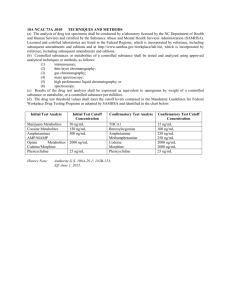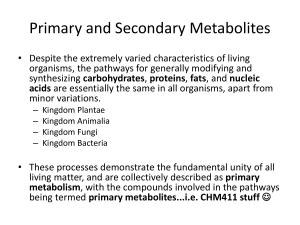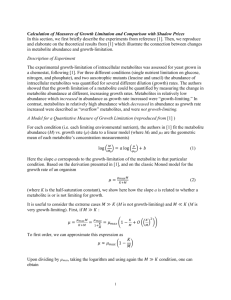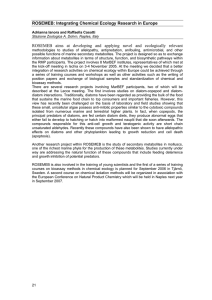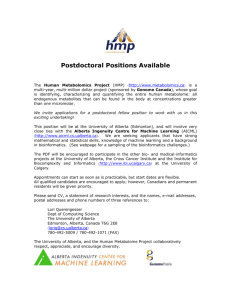Advantages of Polar, Reversed- Phase HPLC - Sigma
advertisement
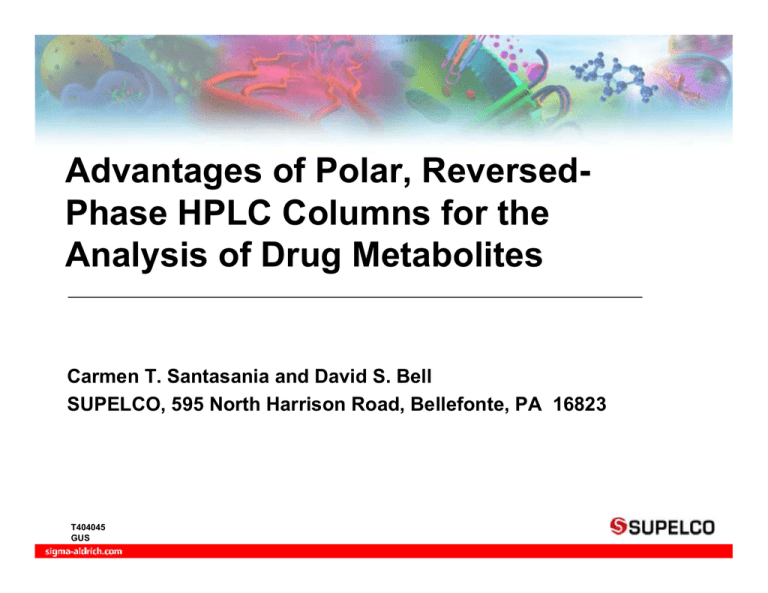
Advantages of Polar, ReversedPhase HPLC Columns for the Analysis of Drug Metabolites Carmen T. Santasania and David S. Bell SUPELCO, 595 North Harrison Road, Bellefonte, PA 16823 T404045 GUS Abstract Small, polar molecules present formidable challenges for liquid chromatographic analyses on traditional reversed-phase columns. These analytes are often poorly retained, necessitating the addition of ion-pair modifiers to the mobile phase. Ion-pair methods tend to lack reproducibility and are often difficult to transfer to quality control laboratories. In addition, the nonvolatile and ion-suppressing nature of the common ion-pair reagents make them less amenable to liquid chromatography-mass spectrometry (LC/MS) experiments. Drug metabolites, in general, fall into this class of small, polar molecules. Due to the complex nature of biological samples and the low levels of metabolites that are often present, LC/MS has become the dominant tool for analysis in this area. It is therefore important to develop tools to adequately retain drug metabolites without the need for detrimental ion-pair reagents. Abstract (contd) In this study several polar, reversed-phase HPLC columns are investigated for their effectiveness at retaining and resolving common types of drug metabolites. These include desmethylated, hydroxylated, sulfated, and glucuronide metabolites. Results regarding specific interactions between stationary phase chemistries and particular classes of metabolites will be discussed. Introduction Problems associated with metabolite analysis: – – – – – Poor retention of polar analytes May require ion-pairing LC/MS compatibility General elution problem Too little or too much selectivity A variety of functionalized, reversed-phase columns are available. The problem: Which is the best phase to use for a particular class of metabolites? Introduction (contd) The goal of this work was to determine what phase or phases provide the best retention and separation for a given class of metabolites. Classes of metabolites studied were: • Hydroxy metabolites • Desmethyl metabolites • Glucuronide metabolites • Sulfated metabolites Experimental Compounds Used in This Study Hydroxy Metabolites Parent Metabolite Chloroquine Hydroxychloroquine Coumarin 7-Hydroxycoumarin Propranolol 4-Hydroxypropranolol Midazolam α -Hydroxymidazolam Chlorzoxazone 6-Hydroxychlorzoxazone Metoprolol 4-Hydroxymetoprolol Desmethyl Metabolites Metabolite Parent Diazepam Nordazepam Clozapine Norclozapine Clomipramine Norclomipramine Deprenyl Nordeprenyl Doxepin Nordoxepin Fluoxetine Norfluoxetine Compounds Used in This Study (contd) Glucuronide Metabolites Parent Metabolite 3'-Azido-3'-deoxythymidine 3'-Azido-3'-deoxythymidine β -D-glucuronide Codeine Codeine β -D-glucuronide Nicotine Nicotine N-β -glucuronide Morphine Morphine 6-β -D-glucuronide Estriol Estriol β -D-glucuronide Acetaminophen p-Acetamidophenyl-β -D-glucuronide Parent Estriol Estrone β -Estradiol Sulfated Metabolites Metabolite Estriol 3-sulfate Estrone 3-sulfate β -Estradiol 3-sulfate Phases Studied and Experimental Conditions Phases Studied • Discovery C18 • Discovery HS F5 • Discovery Cyano • Discovery HS PEG Conditions Columns: Mobile Phase: Temperature: Flow Rate: Detection: Injection Volume: Sample: 5cm x 4.6mm ID, 5µm particles Various ratios of 10mM ammonium acetate, pH 6.98 (unadjusted) and CH3CN 35°C 1.0mL/min, split to mass spectrometer MS, ESI (+) or (-) in Single Ion Recording (SIR) mode 10µL 1 or 5µg/mL (in 50:50 10mM ammonium acetate, pH 6.98 :CH3CN) Procedure • Mobile phase composition adjusted such that parent k' values were between 3 and 6. • Metabolite subsequently run under same conditions as the parent. Criteria • Respective k' of metabolite at least 1.5 • Little or no peak tailing (qualitatively evaluated) • If above criteria met for a given metabolite set, this phase was classified as a good column for this analysis. • Data was collected for each phase with respect to each class of metabolite and reported as % acceptable. Results: Hydroxy Metabolites T able 1. Parent Compound and Hydroxy Metabolite - Discovery C18 Compound % Organic Chloroquine 20 Hydroxychloroquine Coumarin 20 Hydroxycoumarin Propranolol 25 Hydroxypropranolol Midazolam 40 Hydroxymidazolam Chlorzoxazone 25 Hydroxychlorzoxazone Metoprolol 15 Hydroxymetoprolol k' 2.74 1.65 4.42 1.75 4.07 0.86 3.1 1.65 4.12 0.85 4.83 0.59 α 1.66 Comments on Peak Shape tailing Overall Acceptability No 2.53 acceptable Yes 4.73 tailing No 1.88 tailing No 4.85 acceptable No 8.19 tailing No Overall Acceptability = 16% Results: Hydroxy Metabolites (contd) T able 2. Parent Compound and Hydroxy Metabolite - Discovery HS F5 Comments on Overall Peak Shape Acceptability Compound % Organic k' α Chloroquine Hydroxychloroquine Coumarin Hydroxycourmarin Propranolol Hydroxypropranolol Midazolam Hydroxymidazolam Chlorzoxazone Hydroxychlorzoxazone Metoprolol Hydroxymetoprolol 10mM AA in 10% water/ 90% CH3CN 75 10mM AA in 10% water/ 90% CH3CN 45 30 10mM AA in 10% water/ 90% CH3CN 15.82 7.02 5.67 3.00 2.25 tailing No 1.89 acceptable Yes 4.06 2.71 2.68 1.53 4.47 0.08 1.50 acceptable Yes 1.75 acceptable Yes 55.88 acceptable No 1.31 acceptable Yes 3.17 2.42 Overall Acceptability = 66% Results: Hydroxy Metabolites (contd) Table 3. Parent Compound and Hydroxy Metabolite - Discovery Cyano Comments on Overall Peak Shape Acceptability Compound % Organic k' α Chloroquine 20 3.73 1.42 tailing No Hydroxychloroquine 2.62 Coumarin 5 2.06 0.81 acceptable Yes Hydroxycoumarin 2.53 Propranolol 20 4.02 2.10 tailing No Hydroxypropranolol 1.91 Midazolam 25 3.23 1.89 acceptable Yes Hydroxymidazolam 1.71 Chlorzoxazone 5 3.04 1.45 acceptable Yes Hydroxychlorzoxazone 2.09 Metoprolol 5 2.67 3.71 tailing No Hydroxymetoprolol 0.719 Overall Acceptability = 50% Results: Hydroxy Metabolites (contd) Table 4. Parent Compound and Hydroxy Metabolite - Discovery HS PEG Comments on Overall Peak Shape Acceptability Compound % Organic k' α Chloroquine 45 4.54 1.21 tailing No Hydroxychloroquine 3.74 Coumarin no elution no elution no elution No Hydroxycoumarin no retention no retention no retention Propranolol 25 4.79 1.35 tailing No Hydroxypropranolol 3.55 Midazolam 25 3.18 1.59 tailing No Hydroxymidazolam 2 Chlorzoxazone 10 5.74 1.37 acceptable Yes Hydroxychlorzoxazone 4.2 Metoprolol 0 2.13 3.48 tailing No Hydroxymetoprolol 0.612 Overall Acceptability = 16 % Summary of Results Table 5. Summary of Results Metabolite Class Hydroxy Phase % Acceptable for Separation C18 16 HS F5 66 Cyano 50 HS PEG 16 Desmethyl C18 HS F5 Cyano HS PEG 83 83 0 16 Glucuronide C18 HS F5 Cyano HS PEG 33 0 0 0 Sulfated C18 HS F5 Cyano HS PEG 0 0 0 0 Hydroxy Metabolite Example Midazolam and α-Hydroxymidazolam C18 HS F5 Conditions in Tables 1and 2. Note the improved peak shape on the HS F5. Note also the sensitivity increase on the HS F5 column due to the improved peak shape. Desmethyl Metabolite Example Doxepin and Nordoxepin C18 HS F5 Conditions in Tables 1 and 2. Note the improved peak shape on the HS F5. Also note the elution order change on the HS F5 due to the ability of the nordoxepin to interact more strongly with the HS F5 phase as a result of the loss of a methyl group (secondary amine interacts more strongly than a tertiary amine). Glucuronide Metabolite Example Morphine and Morphine-6-β-D-glucuronide C18 Cyano Conditions in Tables 1and 3. C18 appears to offer the most retention of glucuronide metabolites, without the use of ion pairing. Discussion • Tables 1-4 show the “Overall Acceptability” for hydroxy metabolites. • Those metabolites showing a k' >1.5 (1) would be separated well enough from the solvent front, giving acceptable quantitation. • Discovery C18 gave a 16% acceptable rating in meeting the overall criteria. • Polar analytes, especially bases, show poor retention on C18, due to weak dispersive interactions. These analytes often exhibit tailing, even on the most base-deactivated C18 columns, due to silanophilic interactions. • Note that neutral species exhibited acceptable peak shapes, however, even neutral polar analytes (hydroxychlorzoxazone) may be difficult to retain. 1. B. Matuszewski, et al., Anal. Chem. 70 (1998) 882-889. Discussion (contd) • HS F5 gave a better (66%) rating in meeting the overall criteria. • Increase in k' can be explained in terms of the available ionic and polar interactions provided by the HS F5 phase. • Improved peak shape is seen for metoprolol, midazolam, propranolol and chloroquine on the F5 compared to C18. • Improved peak shape due to the availability of polar interactions designed into the fluorinated phase. • Cyano gave a 50% rating in meeting the overall criteria. • High rating can be attributed to the greater availability of polar interactions that can aid in the retention of bases. • Compounds on cyano exhibited more tailing than HS F5, indicating that sufficient availability of ionized silanols may not be present under the conditions studied. Discussion (contd) • HS PEG phase gave a 16% rating in meeting the overall criteria. • Peaks slightly broader on HS PEG than for the other three phases studied, most likely due to the ion exchange character of this phase. The major retention mechanism appears to be hydrophobic in nature. Broad peaks are likely due to a minor contribution from surface silanols. This same procedure was followed for all other compound sets, i.e., the desmethylated, glucuronide and sulfated metabolites. Table 5 summarizes these data. Summary To rank the phases for hydroxy metabolites: • HS F5-best overall • Cyano-second best- but peak shape slightly worse than HS F5 • C18 and PEG-third best • C18 and HS F5 gave good results (83%) for desmethyl metabolites. • HS F5 offers unique selectivity in some cases (basic analytes). • C18 is the best choice for glucuronide metabolites. • Sulfated metabolites are not retained well on any of the four phases studied. Conclusion • Polar reversed phases can be advantageous for use in drug metabolite studies. C18 phases are not always the best choice. • HS F5 shows enhanced retention of basic drug metabolites and, at times, alternate selectivity to traditional C18 phases. • Cyano phase also shows enhanced retention of certain basic analyte metabolites relative to C18. • Neutral drugs and their metabolites are generally more suited for C18 analysis. • Glucuronide and sulfated metabolites studies show the need for a more suitable column chemistry.


